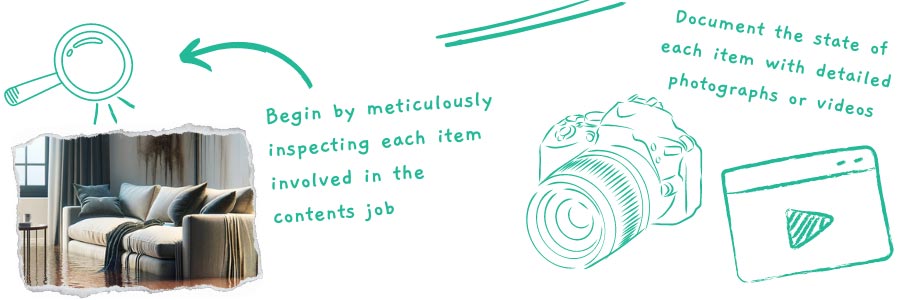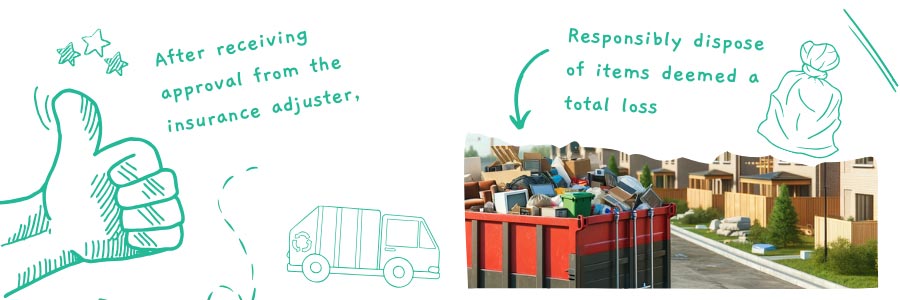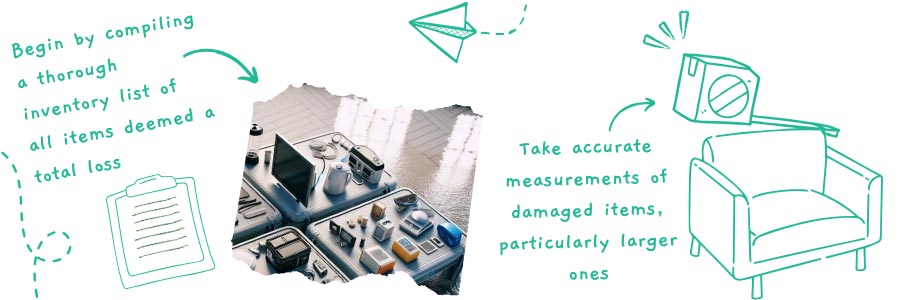Weekly Hands-on How-To powered by KnowHow
How To Inventory a Total Loss

In the wake of a total property loss, emotions are high, and each item deemed a total loss is not just a possession but also a fragment of your client’s life, now irrevocably changed. For restorers, this task, while part of your daily work, holds a profound significance for clients experiencing potentially one of the darkest days of their lives. This process extends well beyond mere documentation. It's about capturing the essence and value of what has been lost to set the stage for recovery, compensation, and ultimately, aiding in the return to normalcy for your clients.
This weekly hands-on how-to, powered by KnowHow, will bolster your team's confidence and, in this case, ensure they're knowledgeable and equipped to navigate the sensitive process of inventorying total loss with competence, confidence, and care.
Now, let's dive into the process of inventorying items deemed a total loss, detailing the key steps and important considerations required.
Step 1: Conduct a Thorough Assessment of Content Damage
Begin by meticulously inspecting each item involved in the contents job to evaluate the extent of the damage. This assessment should be comprehensive, examining the condition of each item and identifying any visible signs of damage or deterioration.
Document the state of each item with detailed photographs or videos; these will serve as vital visual evidence during the inventory and claim process. Accurate and thorough documentation is crucial for accurately assessing the damage and facilitating any necessary restoration or compensation steps.

Step 2: Document Contents Deemed a Total Loss
For items deemed a total loss, create a detailed and precise inventory. Record each item's description, condition, and pertinent details like brand, model, or serial number. Utilize either a digital or physical inventory list to ensure each item is accurately documented. Incorporate photographs or video footage as necessary to enhance and support this documentation.
This careful recording is essential in providing robust evidence for insurance claims and streamlining the settlement process. Accurate and comprehensive documentation of total loss items is a critical step in the claims and restoration procedure.
Step 3: Create a Comprehensive Total Loss Inventory List
In this step, compile a thorough inventory list of all items deemed a total loss from the contents job. Begin by reviewing the earlier damage assessment and identifying all items classified as irreparable or unsalvageable. Cross-reference this with the documentation gathered during the assessment.
For each item on the list, ensure it meets the total loss criteria, which may include severe damage, being beyond repair, or unsafe for use. Document each qualifying item in detail, including its name, brand, model, and any distinguishing features, as well as its location within the property.
Where necessary, take accurate measurements of damaged items, particularly larger ones that may need replacement. This data is essential for the insurance claim process and for determining appropriate compensation. Additionally, include supporting evidence like photographs or videos that clearly show each item's damage.
After completing the inventory list, conduct a thorough review to verify its accuracy and completeness, ensuring all necessary information and documentation are included for each item. This detailed total loss inventory list will be a vital document for submitting claims to the insurance company and securing appropriate compensation for the losses incurred.
Step 4: Present the Total Loss List to the Insurance Adjuster
Presenting the total loss list to the insurance adjuster is a critical step. Begin by providing them with a copy of the report and all supporting documentation to substantiate your findings. During this presentation:
- Communicate clearly and confidently about the total loss items, explaining your rationale for classifying them as such and offering any relevant additional context or information.
- Be ready to address any questions or concerns the insurance adjuster may have. Offer clarifications and additional evidence if needed to support your assessment.
- Pay close attention to the adjuster's feedback or requests for further documentation. Note any suggested adjustments or revisions to the total loss list and remain open to discussing any discrepancies or disagreements.
- Work collaboratively with the adjuster to reach a consensus on the total loss items and their values. This step may involve negotiation or further discussion to ensure the assessment is fair and accurate.
- Once the adjuster reviews and approves the total loss list, document their agreement and any modifications to the original report. Update your records accordingly.
- Proceed with submitting the final claim for the total loss items based on the mutually agreed-upon assessment.
This process is crucial for a smooth claim settlement and requires professionalism, thoroughness, and effective communication.

Step 5: Dispose of Total Loss Items after Approval from the Insurance Adjuster
After receiving approval from the insurance adjuster, responsibly dispose of items deemed a total loss. Adhere to the adjuster's disposal guidelines to ensure legal and environmental compliance. It’s important to document the disposal process, noting the method and date and keeping any relevant disposal receipts. This documentation is crucial for the claims process, confirming the responsible handling of the discarded items.
Note: This Weekly Hands-On How-To was based on this template in KnowHow’s template library.
Inventorying contents that were deemed a total loss is not only a cornerstone in the journey toward your client's recovery and compensation but also typically requires a highly knowledgeable member of your team to coordinate; this is precisely where KnowHow steps in.
Our research of hundreds of workers in the restoration industry told us that a majority of restorers feel they’ve had a “good day” when they have felt productive, and that is precisely why many restorers are turning to KnowHow.
More than just a tool, KnowHow serves as an on-the-job partner for your crew, providing restorers with an extensive array of training resources, SOPs, and instant support on any aspect of the job. Whether you're a newcomer to the field or bring years of expertise, KnowHow’s commitment is to ensure every restorer is thoroughly equipped to approach their tasks with confidence and competence to get the job done right.
Access hundreds of industry-standard templates and discover the full potential of KnowHow's resources for your team at tryknowhow.com.
Looking for a reprint of this article?
From high-res PDFs to custom plaques, order your copy today!







